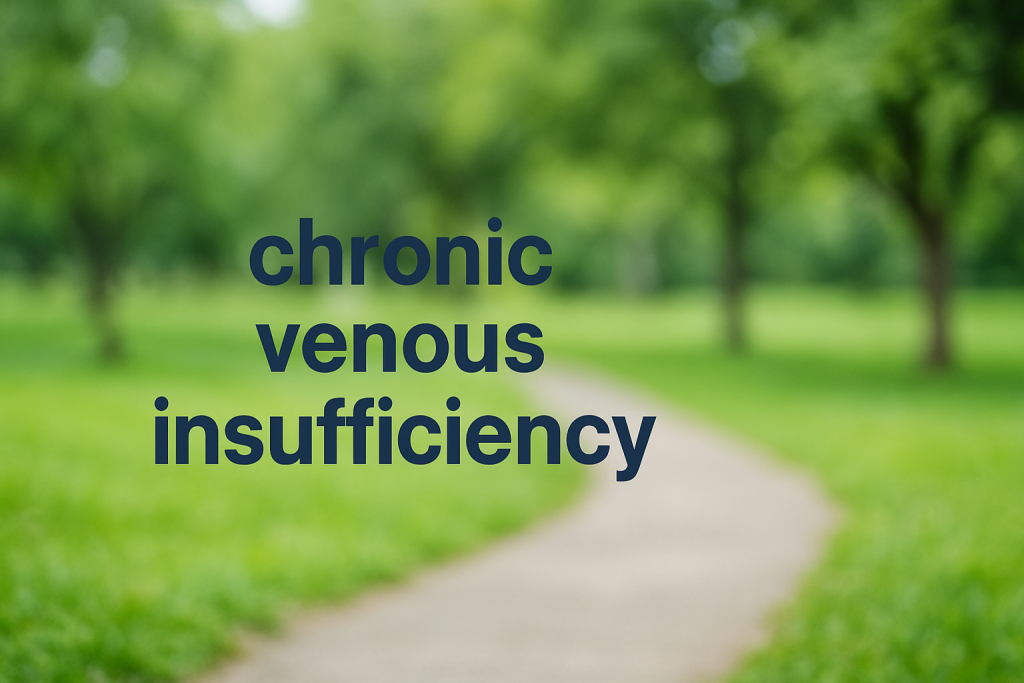Introduction: Understanding CVI

Chronic Venous Insufficiency (CVI) is a widespread vascular disorder that impairs the ability of the veins—especially in the legs—to return blood effectively to the heart. Affecting more than 200 million people globally, CVI is a major contributor to leg discomfort, swelling, skin damage, and even ulceration. The condition is progressive and chronic, meaning it worsens over time if not properly managed.
While often overshadowed by arterial diseases, venous insufficiency is a significant cause of morbidity, especially in adults over 50. The global medical community continues to enhance diagnostic strategies and treatments, especially with innovations introduced in 2025.
What Causes Chronic Venous Insufficiency?
The core problem in CVI is valve failure inside the veins. Normally, these valves prevent blood from flowing backward. When they become damaged or incompetent, blood pools in the lower extremities—this is called venous reflux.
Leading Causes of CVI:
- Deep Vein Thrombosis (DVT): The most common cause; it scars or damages vein valves.
- Varicose veins: Enlarged superficial veins signal valve issues.
- Obesity: Increases venous pressure and impairs blood flow.
- Pregnancy: Hormonal and mechanical changes increase venous pressure.
- Prolonged standing or sitting: Weakens venous return over time.
- Age: Valve function declines naturally with age.
- Smoking: Damages vascular endothelium and promotes inflammation.
- Genetics: Family history plays a strong role.
Fun Fact: Up to 70% of patients with CVI have a family history of varicose veins or leg swelling.
Symptoms of CVI: How to Recognize It Early
Symptoms of CVI can be subtle at first but worsen progressively without intervention. They often fluctuate depending on the patient’s activity and posture.
Common Symptoms:
- Swelling in ankles and calves (edema)
- Heaviness or aching in the legs
- Itching or tingling sensation
- Skin discoloration (brown or reddish tint)
- Visible varicose veins
- Leg cramps or restlessness, especially at night
- Thickened skin or eczema-like patches
- Venous stasis ulcers, usually around the ankles
Worsens with: long periods of standing or sitting
Improves with: leg elevation or walking
Staging & Classification: CEAP System
To standardize diagnosis and treatment, the CEAP classification is used worldwide. It considers clinical signs, etiology, anatomical location, and pathophysiology.
CEAP Clinical Class (Most Used):
| Class | Description |
|---|---|
| C0 | No visible signs |
| C1 | Spider or reticular veins |
| C2 | Varicose veins |
| C3 | Edema |
| C4a | Pigmentation, eczema |
| C4b | Lipodermatosclerosis, atrophie blanche |
| C5 | Healed ulcer |
| C6 | Active venous ulcer |
ICD-10 Code for CVI: I87.2 – Chronic venous insufficiency (peripheral)
Pathophysiology: Venous Reflux and Stasis
In CVI, venous reflux results from the malfunctioning valves, which causes retrograde blood flow. This increases pressure in the veins—a phenomenon known as venous hypertension.
This high pressure leads to:
- Stretching of vein walls
- Capillary leakage
- Inflammation and fibrosis
- Skin and tissue damage (venous dermatitis)
- Chronic wounds (ulcers)
Venous stasis occurs when blood stagnates in the legs, further worsening tissue oxygenation and healing capacity.
Diagnostic Methods: How CVI is Diagnosed
Accurate diagnosis is critical for selecting appropriate therapy.
Gold-Standard Diagnostic Tools:
- Duplex Ultrasound: Measures blood flow and valve competency.
- Photoplethysmography: Evaluates venous refill time.
- Venography: Rarely used; invasive contrast test.
- MRI or CT Venography: For complex or recurrent cases.
In 2025, AI-powered ultrasound interpretation tools are being used in Europe to detect reflux patterns with enhanced precision.
Risk Factors & Complications of CVI
While the causes of CVI relate primarily to venous valve damage, several risk factors amplify the likelihood of developing the condition or worsening its progression:
Major Risk Factors:
- Age > 50 – valve elasticity declines naturally
- Obesity – increased abdominal pressure impedes venous return
- Sedentary lifestyle – lack of muscle contraction reduces calf pump effectiveness
- Family history – genetic predisposition to weak vein walls or valve malformations
- Multiple pregnancies – hormonal shifts and pelvic pressure elevate CVI risk
- Smoking – impairs vascular health and oxygen delivery
- Prolonged sitting/standing – common in certain occupations (e.g., teachers, drivers)
- History of DVT – prior clots damage veins permanently
Common Complications:
- Venous eczema (stasis dermatitis)
- Hyperpigmentation of skin (hemosiderin deposition)
- Lipodermatosclerosis – hardening and thickening of skin tissue
- Venous ulcers – often painful and recurrent
- Cellulitis – bacterial infection of the skin
- Bleeding from superficial veins – especially varicosities
Reminder: Most complications are preventable with early diagnosis and ongoing management.
Treatment Guidelines for CVI (2025 Edition)
Updated international guidelines (2025) emphasize a comprehensive, stepwise approach. Management depends on severity (CEAP stage), patient comorbidities, and lifestyle factors.
1. Conservative Measures
Most first-line therapies are non-invasive and focus on symptom control and slowing progression.
- Graduated compression stockings (20–40 mmHg) – worn daily
- Leg elevation – several times per day
- Walking/exercise – boosts calf muscle pump
- Lifestyle changes – weight loss, quitting smoking
- Avoiding prolonged standing/sitting
Compression remains the cornerstone of CVI therapy.
2. Pharmacological Treatment
Though medications are not curative, they aid symptom relief and enhance circulation.
| Medication | Purpose |
|---|---|
| Diosmin/Hesperidin | Venoactive, reduces edema and pain |
| Pentoxifylline | Improves microcirculation and wound healing |
| Rutosides | Antioxidant, capillary protection |
| Horse Chestnut Extract | Natural agent for swelling |
Topical agents such as antibiotics or hydrogels are used for ulcers and dermatitis.
3. Minimally Invasive Procedures
Indicated for patients with persistent symptoms, advanced CEAP (C3–C6), or cosmetic concerns:
- Endovenous Laser Ablation (EVLA)
- Radiofrequency Ablation (RFA)
- Sclerotherapy (liquid or foam)
- MOCA (Mechanochemical ablation)
These techniques offer high success rates (90–95%), minimal pain, and quick return to normal activity.
4. Surgical Options
Reserved for patients who:
- Failed minimally invasive treatments
- Have extensive varicosities or reflux in multiple systems
- Suffer from recurrent ulcers
Examples:
- High ligation and stripping
- Phlebectomy
- Venous bypass surgery
New & Emerging Treatments (2025 Highlights)
Innovation in venous medicine has yielded exciting new therapies for CVI in 2025:
1. VenaSeal™ (Cyanoacrylate Closure)
- A non-thermal, non-tumescent treatment using medical glue to seal saphenous veins.
- FDA-approved; ideal for patients intolerant to heat-based treatments.
2. Sonovein® (HIFU – High-Intensity Focused Ultrasound)
- First completely non-invasive CVI treatment (no needles/catheters).
- Uses focused sound waves to shut down refluxing veins externally.
3. Biologics and Cell-Based Therapies
- Under clinical trial: stem cells and growth factors to enhance ulcer healing and vascular regeneration.
- May revolutionize care for advanced CEAP (C5–C6).
Preventing Chronic Venous Insufficiency
Although some CVI cases are unavoidable (due to genetics or aging), most are preventable by addressing modifiable risk factors.
Prevention Strategies:
- Stay physically active – even light walking daily helps
- Elevate legs when resting
- Avoid tight clothing around legs and waist
- Manage blood pressure and cholesterol
- Wear compression during long travel or work hours
- Monitor for early signs – swelling, cramps, discoloration
Prevention = less pain, lower costs, and better quality of life.
CVI Global Stats & Trends
- Affects ~40% of adults over age 50 globally
- Women > men, especially post-menopausal
- CVI is more prevalent in Western countries, likely due to lifestyle factors
- Health systems spend billions annually treating venous ulcers alone
Top regions with high CVI rates:
- North America
- Western Europe
- Middle East (due to obesity & sedentary lifestyle trends)
Top 10 Frequently Asked Questions (FAQ)
1. What is the most common cause of chronic venous insufficiency?
Deep vein thrombosis (DVT), which damages the internal valves and leads to reflux.
2. How do you fix venous insufficiency in legs?
Through a combination of compression therapy, exercise, and—if needed—endovenous procedures.
3. What is the new treatment for CVI in 2025?
VenaSeal (cyanoacrylate) and Sonovein (ultrasound) are the most advanced, non-invasive options.
4. What are the early symptoms of CVI?
Leg swelling, fatigue, itching, varicose veins, and night cramps.
5. Is CVI the same as varicose veins?
Not exactly. Varicose veins are one symptom of CVI but not the full condition.
6. Can CVI lead to blood clots?
Yes, stagnant blood increases the risk of thrombosis, especially in deep veins.
7. Do compression stockings really work?
Absolutely. They’re the first-line treatment and prevent further valve damage.
8. Is CVI reversible?
No, but it can be well-managed and its progression slowed or halted.
9. Can young people get CVI?
Yes, especially if they have genetic predisposition, obesity, or prior DVT.
10. Does CVI affect quality of life?
Significantly. It causes chronic pain, skin changes, and ulcers if untreated.
Conclusion: Managing CVI for a Healthier Future
Chronic Venous Insufficiency is a common yet underrecognized vascular disorder. Its impact is far-reaching—not just medically, but socially and economically. The good news? It’s manageable.
With early detection, lifestyle changes, compression, and advanced interventions like VenaSeal™ and Sonovein®, patients can reclaim mobility and comfort. Education and awareness are key—for both the public and healthcare providers.
Stay proactive. Treat early. Live better.





